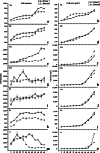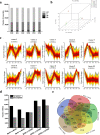Comparative anatomical and transcriptomic insights into Vaccinium corymbosum flower bud and fruit throughout development
- PMID: 34167466
- PMCID: PMC8223347
- DOI: 10.1186/s12870-021-03067-6
Comparative anatomical and transcriptomic insights into Vaccinium corymbosum flower bud and fruit throughout development
Abstract
Background: Blueberry (Vaccinium spp.) is characterized by the production of berries that are smaller than most common fruits, and the underlying mechanisms of fruit size in blueberry remain elusive. V. corymbosum 'O'Neal' and 'Bluerain' are commercial southern highbush blueberry cultivars with large- and small-size fruits, respectively, which mature 'O'Neal' fruits are 1 ~ 2-fold heavier than those of 'Bluerain'. In this study, the ontogenetical patterns of 'O'Neal' and 'Bluerain' hypanthia and fruits were compared, and comparative transcriptomic analysis was performed during early fruit development.
Results: V. corymbosum 'O'Neal' and 'Bluerain' hypanthia and fruits exhibited intricate temporal and spatial cell proliferation and expansion patterns. Cell division before anthesis and cell expansion after fertilization were the major restricting factors, and outer mesocarp was the key tissue affecting fruit size variation among blueberry genotypes. Comparative transcriptomic and annotation analysis of differentially expressed genes revealed that the plant hormone signal transduction pathway was enriched, and that jasmonate-related TIFYs genes might be the key components orchestrating other phytohormones and influencing fruit size during early blueberry fruit development.
Conclusions: These results provided detailed ontogenetic evidence for determining blueberry fruit size, and revealed the important roles of phytohormone signal transductions involving in early fruit development. The TIFY genes could be useful as markers for large-size fruit selection in the current breeding programs of blueberry.
Keywords: Blueberry; Cell expansion; Cell proliferation; Comparative transcriptome; Fruit development; TIFY genes.
Conflict of interest statement
The authors declare they have no competing interests.
Figures






Similar articles
-
Transcriptomic and Physiological Analysis Reveals the Responses to Auxin and Abscisic Acid Accumulation During Vaccinium corymbosum Flower Bud and Fruit Development.Front Plant Sci. 2022 Feb 15;13:818233. doi: 10.3389/fpls.2022.818233. eCollection 2022. Front Plant Sci. 2022. PMID: 35242154 Free PMC article.
-
Generation and analysis of blueberry transcriptome sequences from leaves, developing fruit, and flower buds from cold acclimation through deacclimation.BMC Plant Biol. 2012 Apr 2;12:46. doi: 10.1186/1471-2229-12-46. BMC Plant Biol. 2012. PMID: 22471859 Free PMC article.
-
Fruit Quality and Metabolomic Analyses of Fresh Food Accessions Provide Insights into the Key Carbohydrate Metabolism in Blueberry.Plants (Basel). 2023 Sep 7;12(18):3200. doi: 10.3390/plants12183200. Plants (Basel). 2023. PMID: 37765362 Free PMC article.
-
Abscisic acid stimulates anthocyanin accumulation in 'Jersey' highbush blueberry fruits during ripening.Food Chem. 2018 Apr 1;244:403-407. doi: 10.1016/j.foodchem.2017.10.051. Epub 2017 Oct 10. Food Chem. 2018. PMID: 29120800
-
The roles of nitric oxide in improving postharvest fruits quality: Crosstalk with phytohormones.Food Chem. 2024 Oct 15;455:139977. doi: 10.1016/j.foodchem.2024.139977. Epub 2024 Jun 4. Food Chem. 2024. PMID: 38850982 Review.
Cited by
-
A Study of the Molecular Regulatory Network of VcTCP18 during Blueberry Bud Dormancy.Plants (Basel). 2023 Jul 9;12(14):2595. doi: 10.3390/plants12142595. Plants (Basel). 2023. PMID: 37514210 Free PMC article.
-
Metabolomic and transcriptomic analyses of the flavonoid biosynthetic pathway in blueberry (Vaccinium spp.).Front Plant Sci. 2023 Apr 20;14:1082245. doi: 10.3389/fpls.2023.1082245. eCollection 2023. Front Plant Sci. 2023. PMID: 37152168 Free PMC article.
-
Transcriptomic and Physiological Analysis Reveals the Responses to Auxin and Abscisic Acid Accumulation During Vaccinium corymbosum Flower Bud and Fruit Development.Front Plant Sci. 2022 Feb 15;13:818233. doi: 10.3389/fpls.2022.818233. eCollection 2022. Front Plant Sci. 2022. PMID: 35242154 Free PMC article.
-
Genome-wide identification and comprehensive analysis reveal potential roles of long non-coding RNAs in fruit development of southern highbush blueberry (Vaccinium corymbosum L.).Front Plant Sci. 2022 Dec 13;13:1078085. doi: 10.3389/fpls.2022.1078085. eCollection 2022. Front Plant Sci. 2022. PMID: 36582646 Free PMC article.
-
Genome sequencing and transcriptome analyses provide insights into the origin and domestication of water caltrop (Trapa spp., Lythraceae).Plant Biotechnol J. 2022 Apr;20(4):761-776. doi: 10.1111/pbi.13758. Epub 2021 Dec 11. Plant Biotechnol J. 2022. PMID: 34861095 Free PMC article.
References
-
- Azzi L, Gévaudant F, Delmas F, Hernould M, Chevalier C. Fruit growth in tomato and its modification by molecular breeding techniques. In: Ezura H, Ariizumi T, Garcia-Mas J, Rose J, editors. Functional genomics and biotechnology in Solanaceae and Cucurbitaceae crops. Berlin: Springer; 2016.
Publication types
MeSH terms
Substances
LinkOut - more resources
Full Text Sources
Other Literature Sources
Miscellaneous

